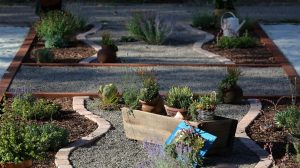Xeriscaping replaces lawn areas with drought-tolerant plants and rock gardens. It also involves amending soil to improve drainage and water penetration.

Xeriscape benefits include reduced maintenance costs, lower water usage, and greater biodiversity. It’s ideal for people concerned with local water restrictions and environmental sustainability. Reduced mowing and chemical use can also help decrease carbon emissions. Visit https://vantaoutdoors.com/xeriscapes/ to learn more.
The key to successful xeriscaping is selecting low-maintenance plants and avoiding those that require extensive watering. Opt for native and drought-tolerant plants adapted to your region’s climate. Succulents like agave and aloe vera store water in their thick leaves, making them a smart choice for xeriscaping. Ornamental grasses such as buffalograss and tall fescue are also great choices for low-water lawns.
To increase the longevity of your xeriscape, make sure you test and amend your soil. Ensure it’s healthy by adding organic matter or using rock dust (a fine, dust-like fertilizer made from ground rock pebbles). Xeriscaping relies on the ability of the soil to hold and absorb moisture, so having the right soil is vital.
Grouping your plants strategically based on their water needs is another crucial step in creating a well-planned, xeriscaped garden. Plants that are high-water users should be planted in shaded areas to reduce evaporation, while those that can withstand less water should be placed in sunny areas. This technique, known as hydrozoning, is essential for a sustainable xeriscape garden.
Aside from saving on watering costs, a xeriscaped garden can also be extremely cost-effective. Xeriscaping reduces the need for mowing, fertilizing, and other gardening services, and it can increase property value. Additionally, a xeriscaped yard is less likely to pollute local water sources such as rivers and lakes.
While xeriscaping may seem simple, it can be challenging to get your garden off the ground. Thankfully, there are many resources available to help you succeed, including guides, videos, and community support groups.
While it may take time and effort to transition to a xeriscaped garden, once you do, you’ll reap the rewards of an easy-care, beautiful yard that looks good with minimal water usage. So, don’t be afraid to put down the hose and pick up the shovel! With a little planning, you can have a thriving garden that requires only the barest minimum of water. And that’s a win for everyone!
Irrigation
Xeriscaping conserves water by utilizing your region’s natural rainfall to nurture the garden. It also reduces the amount of fertilizer needed and minimizes the need for mowing, pruning, and other yard maintenance activities that can be time-consuming.
In a xeriscape landscape, you can replace areas of grass with drought-resistant plants and shrubs. You can also use mulch, rocks, pavers, and other low-water landscaping materials. This type of garden also makes for a more natural environment and supports native wildlife.
To help your xeriscape garden thrive, we recommend choosing native plants that are well-adapted to your specific climate. They typically require less water and are resistant to local insects. Plus, native plants have evolved with the local ecosystem, so they’re more likely to survive and thrive in your garden.
Another key to a successful xeriscape garden is to properly irrigate your garden. We recommend a drip system that delivers the right amount of water at the right times to each plant. This prevents the water from evaporating and encourages deep root growth. We also recommend using grid drip systems, which have emitters (tiny water nozzles) placed every 12 inches across the planting bed to prevent over-watering.
Irrigating your xeriscape garden properly can also save you money in the long run. Because you’re using fewer plants and relying on the weather to provide most of your water, you can cut your water bills significantly. You’ll also spend less time mowing, trimming, and weeding, which means more time enjoying your garden.
Finally, a well-designed xeriscape can actually enhance your property’s value by improving curb appeal and decreasing your energy costs. This sustainable landscape trend is becoming more popular in Central and South Texas and it’s the perfect option for a greener, more beautiful garden without sacrificing beauty or comfort.
Originally developed in response to drought conditions, xeriscaping is now a sought-after landscaping solution for homeowners who value both beauty and sustainability. Featuring smart plant selection, efficient irrigation systems, and strategic design principles, xeriscaping is revolutionizing high-end landscaping by providing the best of both worlds. From stunning desert gardens with cacti and succulents to lush rain gardens, these water-wise yards offer an ideal blend of luxury and environmental stewardship.
Mulching
A good xeriscaping mulch will help conserve soil moisture and prevent evaporation from the sun. Mulching also reduces the need for weed control. When using mulch, choose one that is slow to decompose. Organic mulches such as shredded bark, hay, or leaves work well in xeriscape garden beds. Gravel mulch is another option, as it helps to promote water infiltration and discourage weed growth. Whether you use organic or inorganic mulch, apply it thickly to be effective.
Many xeriscaped gardens feature native plants that are well-adapted to the area. Incorporating these drought-tolerant species will ensure that the horticultural ecosystem is balanced and sustainable, while minimizing the need for irrigation or fertilizer.
If your xeriscape garden features trees, shrubs, and perennials, you can use a variety of different blooming plants to add color throughout the year. These include flowering native perennials such as broom, yarrow, and lupine, which can provide colorful flowers in spring, summer, and fall; and ornamental grasses like buffalograss, oatgrass, and fescue, which can bloom throughout the summer.
Incorporating xeriscape principles into your landscape design will save money and time in the long run. You’ll spend less money on expensive irrigation systems and supplemental fertilizer, and you won’t have to devote as much time to your garden. In fact, most xeriscaped gardens only need occasional maintenance such as mowing the turf or deadheading spent penstemon blooms.
While xeriscaping can be an excellent way to conserve water and protect the environment, it’s important to remember that it’s not about making your yard look like a desert (unless you want it to). It’s all about finding the right balance of beauty, sustainability, and practicality for your garden.
Choosing plant varieties that are adapted to your climate, utilizing efficient watering practices, and applying mulch efficiently are all critical components of a successful xeriscape garden. By taking these steps, you can create a garden that is beautiful and vibrant, without draining your wallet or the local water supply. So don’t be afraid to give it a try! Your garden, your wallet, and the environment will thank you.
Maintenance
While xeriscaping can save you money on water bills in the long run, it requires some time and energy to maintain. Your yard will need less watering than traditional landscaping, but you still need to weed, prune, and fertilize regularly. This is why it’s important to choose low-maintenance xeriscape plants. These plants are adapted to your local climate and are more likely to survive in the face of drought.
In addition to saving water, a xeriscape garden can also save you money on plant materials and lawn care equipment. Many xeriscape plants are also able to thrive without the use of pesticides and other chemicals. This can be a huge benefit for families with children and pets who may want to reduce their chemical exposure.
Unlike the clumpy grasses found in most traditional landscapes, xeriscaping utilizes a variety of plants that can thrive in a range of soil conditions. This makes it possible for homeowners in almost any region to enjoy the benefits of a drought-tolerant landscape. You may also find that your xeriscape is actually more appealing than a yard full of droopy, overgrown grasses.
Some regions even offer incentives or rebates for home and business owners who implement water-saving landscaping practices like xeriscaping. This can be a great way to offset the initial costs of making the switch to a water-wise landscape.
If you’re interested in xeriscaping your yard, be sure to talk to a professional landscaping service. They’ll be able to help you choose the right mix of plants and hardscapes that will best fit your property. You’ll also need to check with your HOA or local government for any rules regarding this type of landscaping.
Xeriscaping can seem too good to be true: less maintenance and a unique look for your yard, all while saving on water costs. While it’s true that xeriscape is a great choice for most regions, it’s not a good idea in every situation. If you’re not sure whether a xeriscape garden is right for you, consider using it in a small, decorative area of your yard to see how it works.
